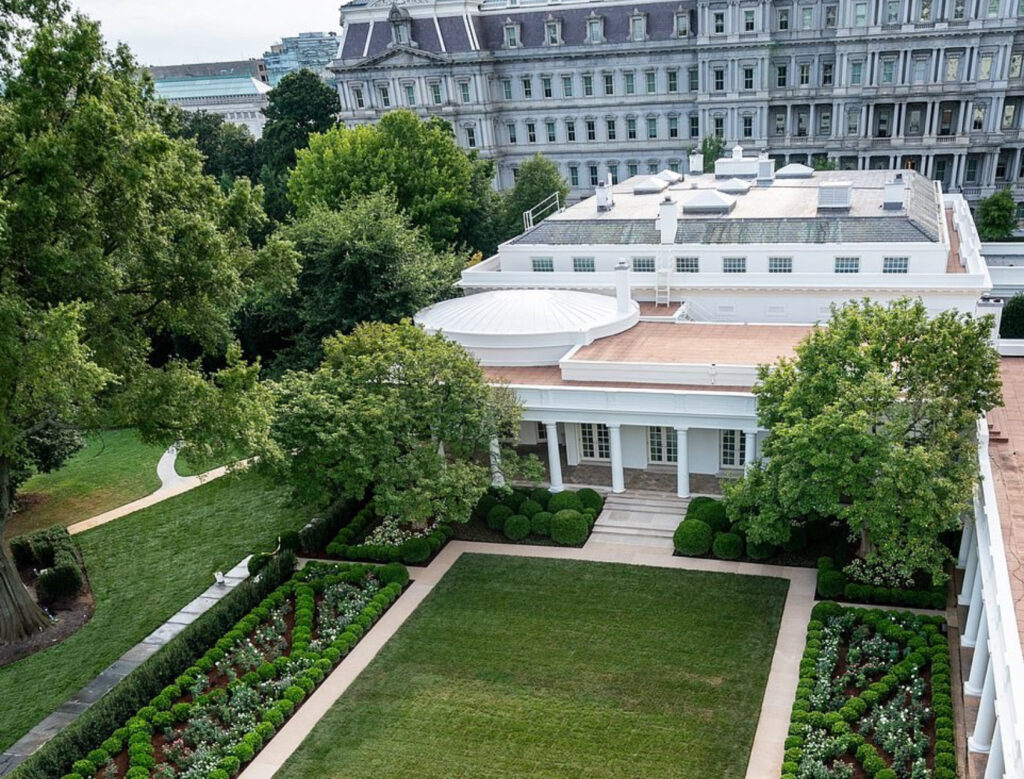
There is a certain poetry in the act of opening a garden. It is a gesture that is both intimate and grand—a subtle invitation to linger in curated serenity, to witness cultivation as both art and diplomacy.
When First Lady Melania Trump resumed the cherished tradition of opening the White House gardens to the public, she did more than extend a springtime courtesy.
She activated a cultural ritual, one that unites history, aesthetics, and the democratic ideal that even the most exclusive spaces can, at times, belong to the people.
The Spring Garden Tours, held on the grounds of America’s most symbolically significant residence, are more than a seasonal event. They are a moment of soft power, a rarefied glimpse into the confluence of horticulture and heritage.
For Melania Trump, a First Lady known for her preference for discretion and minimal public appearance, the decision to host the tours and personally guide aspects of the initiative spoke volumes—albeit in a language of restrained elegance and strategic tradition.
A Garden With Memory: The Role of Green Spaces at the White House
The White House gardens are not incidental backdrops to political life; they are, in many ways, central to the ceremonial and symbolic operations of the executive branch. From the Rose Garden—long the venue for press conferences and state welcomes—to the Jacqueline Kennedy Garden, with its neat parterres and balanced neoclassical geometry, these spaces reflect the personal and political tastes of each administration.
Designed with deliberate intent, they are living extensions of the First Family’s values. For Melania Trump, whose White House legacy includes the “Be Best” initiative and a meticulous restoration of the Rose Garden in 2020, the gardens were less an accessory and more an expression. Her aesthetic—controlled, classically informed, and often European in discipline—translated fluently into the horticultural language of the White House grounds.
By inviting the public into these spaces, Mrs. Trump aligned herself with the most time-honored traditions of First Ladies past, while quietly reinforcing her particular vision: poised, refined, and intentional.
Opening the Gates: An Invitation to All Americans
On a sun-drenched April weekend, the gates of the White House gardens swung open to welcome visitors from across the United States. Families with children, elderly couples, tourists from as far as California or as close as Capitol Hill, all streamed onto the South Lawn with the reverent enthusiasm typically reserved for national monuments. And indeed, that is what they were witnessing—a national monument in bloom.
“Spring is a beautiful time of renewal,” the First Lady said in a prepared statement, “and I am pleased to continue the tradition of opening our gardens and grounds to the American people.” Her words, simple and polite, bore the weight of legacy. The gesture, though quiet, echoed the openness that has historically marked White House tours and public invitations—a statement that access and beauty need not be mutually exclusive.
Melania Trump’s choice to emphasize the universality of the occasion—“open to all Americans”—resonated against a politically polarized backdrop. It was, in effect, a moment of unity carved out through tulips, cherry blossoms, and native shrubs.
Florals With Meaning: A Quiet Language of Influence
Fashion editors often speak of florals in spring with a kind of wink—groundbreaking, indeed—but in the White House gardens, florals are not a trend but a tradition. Their inclusion is less about seasonal novelty and more about enduring cultural memory.
Under Melania Trump’s influence, the garden displays exhibited restraint and classical sensibility. The plantings favored symmetry and heritage breeds, offering a cultivated nod to historic gardens of Europe while remaining distinctly American in scope. Tulips and hyacinths, symbols of renewal and peace, flourished beside boxwood hedges and perennial borders, their placement intentional, their bloom symbolic.
As with couture, each decision—each planting, each pruning, each invitation—communicated a larger message. The First Lady’s approach was not performative but deliberate: a kind of aesthetic diplomacy played out through camellias and crabapple trees. Just as one might decode a fashion collection’s silhouettes or fabrications, so too could one read into the architecture of her garden tours—a composition of civility, refinement, and curated accessibility.
In the Footsteps of History: A Tradition of First Ladies
To understand the significance of the Spring Garden Tours is to place Melania Trump in a historical lineage of First Ladies who have cultivated the White House gardens as cultural capital. From Dolley Madison’s open-house spirit to Michelle Obama’s kitchen garden that championed health and community, each woman shaped the landscape in her image.
Jacqueline Kennedy brought French garden designers to instill European grace in the East and West Wing grounds. Lady Bird Johnson infused her native love of wildflowers into the national consciousness. Hillary Clinton embraced the gardens as an extension of soft diplomacy, and Laura Bush honored native Texas flora.
Melania Trump’s participation in this tradition is telling. Rather than disrupt the past, she chose to echo it. Her restoration of the Rose Garden in 2020, though controversial among design purists, was executed with historical blueprints and archival research. It was a revision, not a reinvention. And her continuation of the Spring Garden Tours affirmed a commitment to openness, despite the administration’s often tumultuous relationship with the media and public scrutiny.
The Garden as a Portrait: Elegance, Intention, and Control
In many ways, the gardens were Melania Trump’s truest portrait as First Lady. While her public speeches were infrequent and her interviews even rarer, her choices in design, fashion, and restoration were saturated with personal style. The garden tours offered the public a chance to glimpse this sensibility: one of elegance balanced with control.
Visitors reported that the gardens were immaculate, almost museum-like in their precision. Volunteers handed out brochures detailing each planting. Secret Service agents hovered at a distance, more visible than usual but less obtrusive than expected. It was an experience not unlike attending a high fashion show—not in glitz, but in atmosphere. Everything was choreographed, from the security lines to the sightlines of the South Lawn.
Children posed beside fountains; veterans sat quietly on folding chairs, taking in the scent of magnolias. One could almost forget, for a moment, that this was the epicenter of American executive power. That was perhaps the point: to remind visitors that beauty is a right, not a privilege.
Public Space, Private Meaning: The Political Subtext of a Flowering Lawn
It would be naïve to suggest that the Spring Garden Tours existed entirely outside politics. The White House, after all, is both home and headquarters, a symbol of power as much as hospitality. In opening the gardens, Mrs. Trump wielded soft power with discretion, aligning herself with apolitical traditions at a time of deep national division.
Her presence was not ornamental. It was strategic. And in that strategy, there lay a kind of fashion logic: to say more by saying less. To let fabric speak, or in this case, flowers.
In the polarized climate of her husband’s presidency, Melania Trump often floated above the fray, neither openly challenging nor entirely embracing the political rhetoric of the time. Her gardens—timeless, elegant, and historically anchored—provided a platform that was both safe and subversively powerful.
The Afterimage: What Endures Beyond the Season
As the petals fall and the last guests exit the South Lawn, one wonders what remains. The Spring Garden Tours are ephemeral by design, but their impression lingers. Visitors carry home photographs and memories, while the rest of the country receives filtered glimpses through news images and social media posts. The moment is brief, but the symbolism is enduring.
For Melania Trump, whose tenure as First Lady was often marked by privacy and polished reserve, the gardens offered a rare opening—both literal and metaphorical. They stand now as a part of her legacy: understated, traditional, and precisely curated.
In a culture often clamoring for spectacle, there is something quietly revolutionary about restraint. About roses, not rallies. About inviting Americans to walk through magnolia-lined paths and see their democracy, for once, in bloom.
When Beauty Becomes a Gesture
The Spring Garden Tours remind us that politics is not always loud. Sometimes, it is expressed in design, in florals, in the scent of a blossoming tree. First Lady Melania Trump’s continuation of this tradition underscores a nuanced chapter in the long history of American first ladies: one where fashion, diplomacy, and cultural stewardship converge.
No comments yet.








